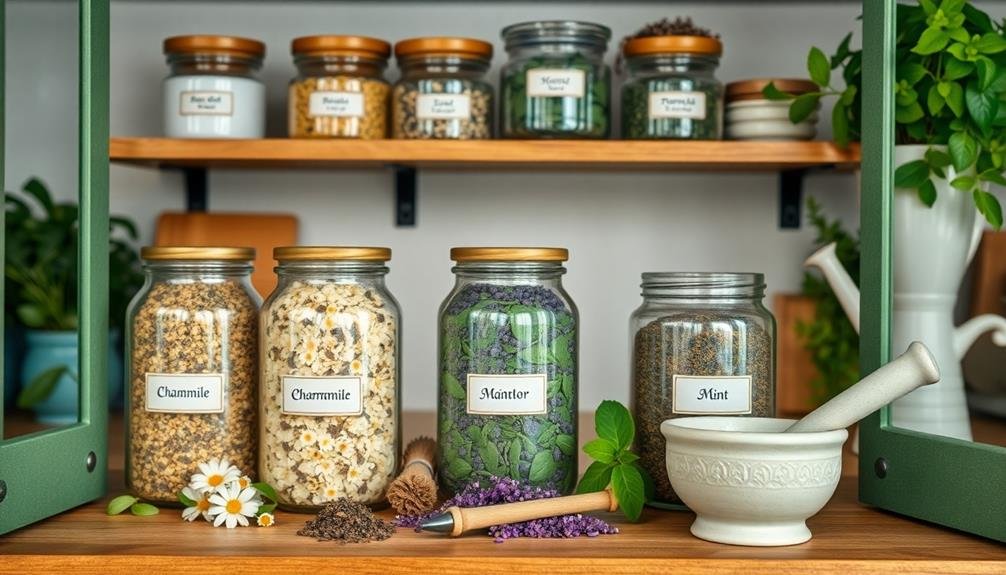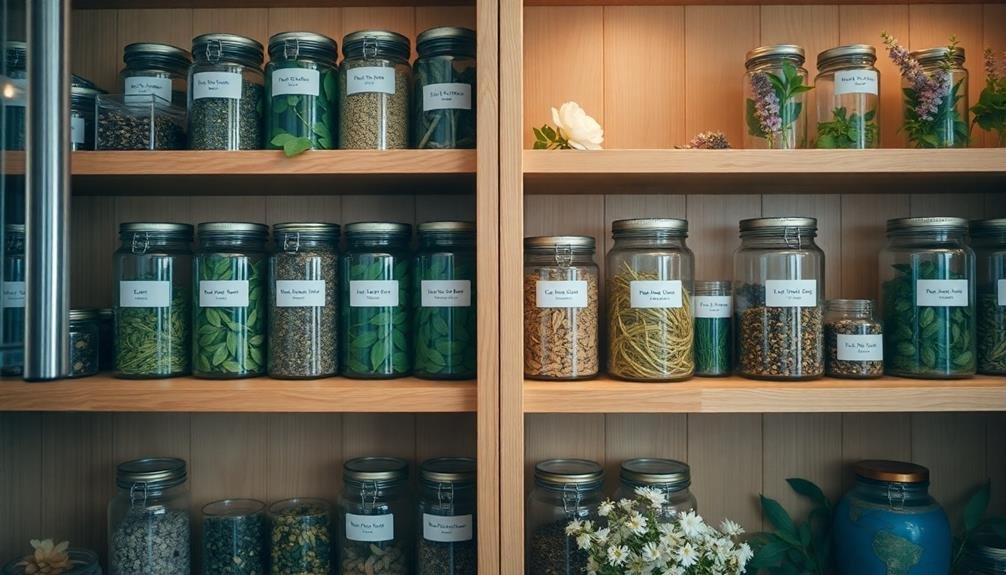To streamline your tea cabinet and organize dried herbs efficiently, start by evaluating your collection. Lay everything out for visibility and check for expiration dates. Categorize herbs by use or flavor while eliminating duplicates to save space. Choose airtight containers that protect from light, like dark glass or metal tins. Clearly label each container for quick access, noting storage dates if desired. Don't forget to maintain your herbs regularly—rotate them and check for mold. With a plan in place, you can enjoy fresh, flavorful blends. Discover more tips to transform your tea cabinet into a treasure of flavor.
Assess Your Current Collection

Before diving into organizing your dried herbs, take a moment to evaluate your current collection. Open your cabinet and pull out all your dried herbs. Lay them out on a clean surface to get a clear view of what you have. Check for expiration dates, as some herbs lose their potency over time. Toss any that are stale or expired—keeping only the freshest options will enhance your tea experience.
Next, categorize the herbs based on their uses or flavors. You might group them into categories like calming, energizing, or digestive. This helps you recognize which herbs you use most often and which ones you might've duplicates of. If you discover that you have several containers of chamomile, for instance, consider if you really need all of them or if it's time to consolidate.
Now's also a great time to note any herbs you might be missing. Is there a particular blend you love but don't have all the ingredients for? Jot down what you need.
Choose Appropriate Storage Containers
When choosing storage containers for your dried herbs, consider the material options that best preserve freshness.
Glass jars, plastic containers, and metal tins each have their advantages, so pick what suits your needs.
Don't forget to label them for easy access, making it simple to find your favorite herbs when you need them.
Container Material Options
Choosing the right container material for storing dried herbs is essential for maintaining their flavor and potency. You've got several options, each with its pros and cons.
Glass containers are a popular choice because they're non-reactive, easy to clean, and won't absorb odors or moisture. Opt for dark or opaque glass to shield your herbs from light, which can degrade their quality.
Plastic containers are lightweight and convenient, but make certain you choose BPA-free options to avoid chemical leaching. While they're generally less expensive, they can absorb odors over time, which might affect your herbs.
Metal containers, like tin or stainless steel, provide excellent protection but can react with certain herbs. If you prefer metal, look for food-grade options with an inner lining to prevent this issue.
Lastly, ceramic containers are beautiful and effective at keeping moisture out, but they can be heavy. Verify they're airtight to maintain freshness.
Whichever material you choose, prioritize airtight seals and light protection to keep your dried herbs vibrant and flavorful for longer.
Labeling for Easy Access
Once you've selected the right containers for your dried herbs, labeling them is the next step to confirm easy access. Clear labels help you quickly find what you need, whether it's for a soothing tea blend or a culinary dish.
Start by choosing a labeling method that works best for you. You can use pre-printed labels, a label maker, or even handwritten tags.
Make certain each label includes the herb's name and, if desired, the date you stored it. This helps you keep track of freshness.
Consider color-coding your labels based on categories, like teas, spices, or medicinal herbs, to make it even easier to locate specific items at a glance.
Place the labels on the front of the containers, making sure they're visible when stacked. If you're using jars, consider labeling the lids for easy identification.
Lastly, don't forget to update your labels if you refill or change any herbs. Keeping your labels current guarantees you always have a well-organized tea cabinet, making your herb selection process a breeze.
Happy organizing!
Labeling for Easy Access

Effective labeling transforms your collection of dried herbs into an organized treasure trove. When you can easily identify each herb, you'll save time and enhance your culinary creations.
Start by choosing a labeling method that suits your style, whether it's handwritten tags, printed labels, or chalkboard stickers.
To create a system that works for you, consider the following:
- Name of the Herb: Clearly write the herb's name to avoid confusion.
- Date of Harvest: Include the date you dried the herb for freshness tracking.
- Usage Tips: Add a brief note on how to use the herb or its flavor profile.
Place the labels on the jars or containers where you store your herbs. Confirm they're visible and legible.
This simple step not only elevates the aesthetic of your cabinet but also makes accessing your herbs a breeze. With everything clearly labeled, you'll feel empowered to experiment with different flavors and combinations.
Optimal Drying Techniques
When it comes to drying herbs, employing the right techniques can make a significant difference in flavor and potency. First, consider air drying, which works best for herbs with low moisture content. Simply tie the stems together and hang them upside down in a warm, dry, and well-ventilated area. This method helps retain essential oils and flavors.
If you're short on time, you might prefer using a dehydrator. Set it to a low temperature to avoid cooking the herbs. Spread the leaves evenly on the trays and check them regularly for doneness. Properly dried herbs should be brittle and crumble easily.
Another efficient method is using your oven. Set it to the lowest temperature, ideally around 180°F (82°C). Spread the herbs on a baking sheet in a single layer, and keep the door slightly ajar to allow moisture to escape. Check every 30 minutes until they're fully dried.
Whichever method you choose, always store your dried herbs in airtight containers, away from light and moisture. This guarantees you preserve their flavor and potency for longer, making your tea cabinet an aromatic delight.
Creating Custom Tea Blends

Creating custom tea blends can be a delightful way to experiment with flavors and aromas that suit your taste. With your dried herbs organized, you can easily mix and match to create unique combinations that invigorate your senses.
Start by choosing a base, like green or black tea, and then layer in additional herbs for flavor and health benefits.
Consider these ideas for your custom blends:
- Herbs for Relaxation: Chamomile, lemon balm, and lavender can help you unwind after a long day.
- Boosting Immunity: Echinacea, ginger, and peppermint can support your immune system while adding a revitalizing kick.
- Floral Notes: Hibiscus, rose petals, and jasmine can elevate your blend with lovely fragrances and vibrant colors.
Once you've selected your ingredients, measure them carefully. A good rule of thumb is to start with one part base tea and two parts herbs, adjusting to your preference.
Experimentation is key, so take notes on your favorite combinations. Soon, you'll have a collection of delightful custom blends that not only taste amazing but also cater to your wellness needs.
Enjoy the process and sip your creations with pride!
Regular Maintenance and Rotation
Maintaining your dried herbs is just as important as crafting those custom tea blends. Regular maintenance guarantees your herbs stay fresh and potent, enhancing the quality of your teas.
Start by checking your herbs every few months. Look for any signs of moisture or mold, and discard any that appear compromised.
Next, rotate your stock. Use the first-in, first-out method: always use the oldest herbs first to keep your collection fresh. Label each container with the purchase date, so you know what needs to be used up.
Store your herbs in a cool, dark place away from sunlight, which can degrade their quality. Glass jars with airtight seals work best for preserving flavor.
Frequently Asked Questions
What Types of Herbs Are Best for Tea Blends?
When creating tea blends, consider herbs like chamomile for relaxation, peppermint for digestion, and ginger for warmth. You'll enjoy experimenting with combinations that suit your taste and health needs, enhancing your tea experience.
How Can I Tell if My Dried Herbs Are Still Good?
To tell if your dried herbs are still good, check for color, aroma, and texture. If they've lost their vibrant hue, scent, or feel crumbly, they're likely past their prime and should be discarded.
Are There Specific Storage Conditions for Herbs?
Yes, there are specific storage conditions for herbs. Keep them in a cool, dark place, away from heat and moisture. Use airtight containers to preserve their flavor and potency for longer periods.
Can I Mix Different Types of Herbs in One Container?
You can mix different types of herbs in one container, but it's best to combine those with similar flavors or uses. This way, you'll enhance your blends and avoid overpowering tastes in your recipes.
How Do I Clean My Tea Cabinet Effectively?
To clean your tea cabinet effectively, start by removing all items. Wipe down surfaces with a damp cloth, check for expired products, and reorganize by type or frequency of use for easy access.
In Summary
By streamlining your tea cabinet, you'll not only save time but also enhance your tea-drinking experience. Regularly assess your collection, choose the right storage containers, and keep everything labeled for easy access. Embrace ideal drying techniques to maintain freshness, and don't hesitate to create custom blends that reflect your taste. Finally, make it a habit to maintain and rotate your herbs, ensuring you always have the best selections at your fingertips. Happy brewing!





Leave a Reply